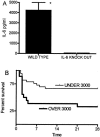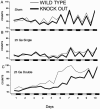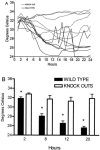Role of interleukin-6 in mortality from and physiologic response to sepsis
- PMID: 15845478
- PMCID: PMC1087378
- DOI: 10.1128/IAI.73.5.2751-2757.2005
Role of interleukin-6 in mortality from and physiologic response to sepsis
Abstract
Previous studies have suggested that interleukin-6 (IL-6) serves as both a marker and a mediator for the severity of sepsis. We tested whether interleukin 6 knockout (IL-6KO) mice were more susceptible to sepsis mortality induced by cecal ligation and puncture. IL-6KO and wild-type (WT) mice were subjected to increasing degrees of sepsis severity. Physiologic support was given with fluids and appropriate antibiotics. Plasma IL-6 levels were determined 6 h after the onset of sepsis, and a complete hematologic profile was performed on day 2. As expected, increasing sepsis severity resulted in greater and more rapid mortality. However, the mortality was nearly identical in the IL-6KO and WT mice. All WT septic mice had high plasma levels of IL-6 6 h after the onset of sepsis, while IL-6KO were near or below the lower limit of detection. Among the WT mice, mortality was significantly higher in mice with plasma IL-6 >3,000 pg/ml. Both IL-6KO and WT mice destined to die in the early stages of sepsis had substantial and nearly identical weight gain in the first 24 h. However, at later stages the WT mice had significantly greater weight loss than the KO mice. The KO mice failed to develop the characteristic hypothermia within the first 24 h of severe sepsis routinely observed in the WT mice. These data demonstrate that IL-6 serves as a marker of disease severity in sepsis and does modulate some physiologic responses, but complete lack of IL-6 does not does not alter mortality due to sepsis.
Figures







References
-
- Andrejko, K. M., J. Chen, and C. S. Deutschman. 1998. Intrahepatic STAT-3 activation and acute phase gene expression predict outcome after CLP sepsis in the rat. Am. J. Physiol. 275:G1423-G1429. - PubMed
-
- Arons, M. M., A. P. Wheeler, G. R. Bernard, B. W. Christman, J. A. Russell, R. Schein, W. R. Summer, K. P. Steinberg, W. Fulkerson, P. Wright, W. D. Dupont, and B. B. Swindell. 1999. Effects of ibuprofen on the physiology and survival of hypothermic sepsis. Crit. Care Med. 27:699-707. - PubMed
-
- Bernard, G. R., J. L. Vincent, P. F. Laterre, S. P. LaRosa, J. F. Dhainaut, A. Lopez-Rodriguez, J. S. Steingrub, G. E. Garber, J. D. Helterbrand, E. W. Ely, C. J. Fisher, Jr., and Recombinant Human Protein C Worldwide Evaluation in Severe Sepsis (PROWESS) Study Group. 2001. Efficacy and safety of recombinant human activated protein C for severe sepsis. N. Engl. J. Med. 344:699-709. - PubMed
Publication types
MeSH terms
Substances
Grants and funding
LinkOut - more resources
Full Text Sources
Other Literature Sources
Medical
Molecular Biology Databases
Research Materials

